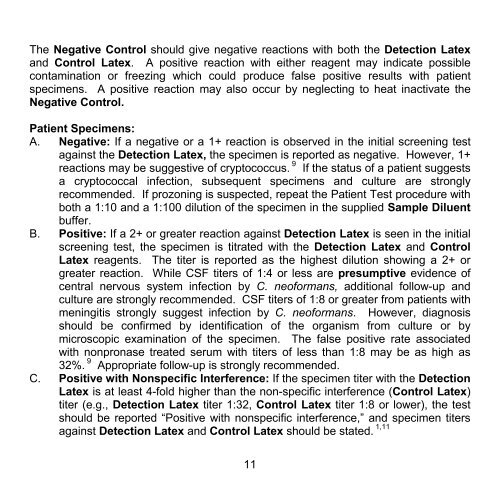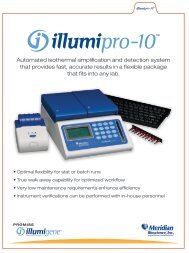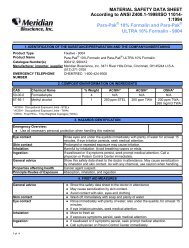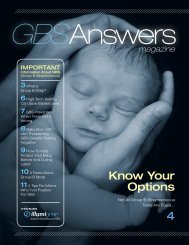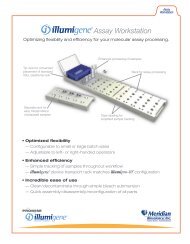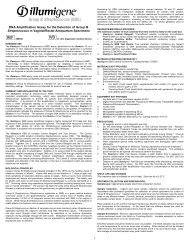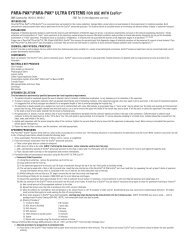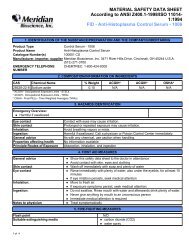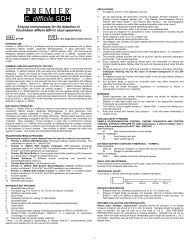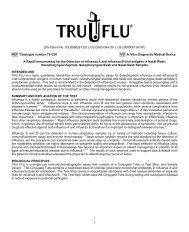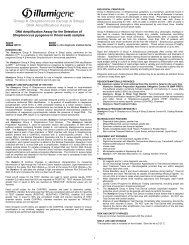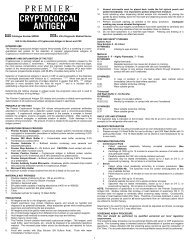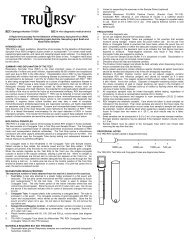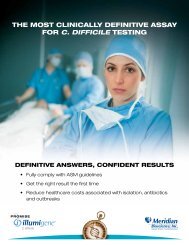Cryptococcal Antigen Latex Agglutination System (CALAS®)
Cryptococcal Antigen Latex Agglutination System (CALAS®)
Cryptococcal Antigen Latex Agglutination System (CALAS®)
Create successful ePaper yourself
Turn your PDF publications into a flip-book with our unique Google optimized e-Paper software.
The Negative Control should give negative reactions with both the Detection <strong>Latex</strong><br />
and Control <strong>Latex</strong>. A positive reaction with either reagent may indicate possible<br />
contamination or freezing which could produce false positive results with patient<br />
specimens. A positive reaction may also occur by neglecting to heat inactivate the<br />
Negative Control.<br />
Patient Specimens:<br />
A. Negative: If a negative or a 1+ reaction is observed in the initial screening test<br />
against the Detection <strong>Latex</strong>, the specimen is reported as negative. However, 1+<br />
reactions may be suggestive of cryptococcus. 9 If the status of a patient suggests<br />
a cryptococcal infection, subsequent specimens and culture are strongly<br />
recommended. If prozoning is suspected, repeat the Patient Test procedure with<br />
both a 1:10 and a 1:100 dilution of the specimen in the supplied Sample Diluent<br />
buffer.<br />
B. Positive: If a 2+ or greater reaction against Detection <strong>Latex</strong> is seen in the initial<br />
screening test, the specimen is titrated with the Detection <strong>Latex</strong> and Control<br />
<strong>Latex</strong> reagents. The titer is reported as the highest dilution showing a 2+ or<br />
greater reaction. While CSF titers of 1:4 or less are presumptive evidence of<br />
central nervous system infection by C. neoformans, additional follow-up and<br />
culture are strongly recommended. CSF titers of 1:8 or greater from patients with<br />
meningitis strongly suggest infection by C. neoformans. However, diagnosis<br />
should be confirmed by identification of the organism from culture or by<br />
microscopic examination of the specimen. The false positive rate associated<br />
with nonpronase treated serum with titers of less than 1:8 may be as high as<br />
32%. 9 Appropriate follow-up is strongly recommended.<br />
C. Positive with Nonspecific Interference: If the specimen titer with the Detection<br />
<strong>Latex</strong> is at least 4-fold higher than the non-specific interference (Control <strong>Latex</strong>)<br />
titer (e.g., Detection <strong>Latex</strong> titer 1:32, Control <strong>Latex</strong> titer 1:8 or lower), the test<br />
should be reported “Positive with nonspecific interference,” and specimen titers<br />
against Detection <strong>Latex</strong> and Control <strong>Latex</strong> should be stated. 1,11<br />
11


